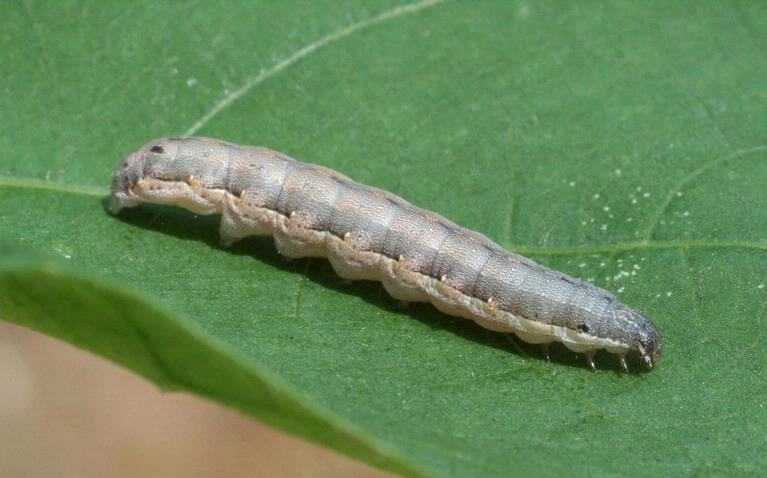The beet armyworm (Spodoptera exigua)
The beet armyworm (Spodoptera exigua) is a a pest moth that was native to Southeast Asia before spreading to other regions of the world. It is found in warmer parts of Africa, America, Asia, and Europe but also occurs in greenhouses in cooler regions. It closely resembles the other members of the genus Spodoptera (armyworms) that is the fall armyworm, yellow-striped armyworm, and the southern armyworm. However, the beet armyworm is characteristically green at the larval stage. Usually, it has two dark dots near the head, on both sides. The adult moth is grayish-brown.
Life cycle
Beet armyworm undergoes a complete metamorphosis, that is, the egg, larvae, pupae, and adult. Since this insect thrives in a warm climate, it overwinters in the dormant stage as a pupa.
Egg: An adult female moth lays a swarm of between 50 – 150 fertilized eggs on the lower side of the plant leaf or at the tips of the shoots. When examined from above, the eggs appear to be circular. However, a closer view reveals that the egg is pointed. They range from green to white in appearance and are coated with whitish hairs and scales from the mother. The eggs hatch into larvae in 2-3 days under favorable warm conditions.
Larvae: This is the destructive form of the beet armyworm. It is usually green in color and passes through five stages (instars) which take roughly three weeks.
Pupa: The pupa is the dormant state of the beet armyworm. It occurs on the soil and involves the caterpillar enclosing itself in a cubicle made of sand and other particles. The caterpillar secretes a sticky substance to bind together the particles. Pupation occurs mostly in winter.
Adult: The pupa takes about seven days to turn into an adult moth. Adults are grayish-brown in color with a wingspan of 1 – 1.2 inches. Moths start to mate immediately after appearing. Females start to lay eggs 2 – 3 days after mating. An adult moth dies about ten days after emerging.
Beet armyworm (Spodoptera exigua) larva. Photo by: Russ Ottens, University of Georgia, Bugwood.org
A group of young beet armyworm larvae in cotton. Photo by John C. French Sr., Retired, Universities:Auburn, GA, Clemson and U of MO, Bugwood.org
Hosts
Beet armyworm is a widely polyphagous pest. It feeds on a diverse range of host plants including vegetables, field crops and flowers. Among its hosts are beans, beets, broccoli, cabbages, cauliflowers, chicken peas, eggplants, lettuces, onions, bell peppers, potatoes (Irish and sweet), tomatoes, turnips, corn, cotton, melon, peanut, sorghum, soybeans, sunflower, and tobacco. In addition, it attacks wild plants, for example, pigweed.
Damage
Beet armyworm is destructive to crop plants at the larvae stage of development. The caterpillars feed and damage plant leaves, flowers, fruits, and apical buds. Newly hatched larvae feed in groups but become solitary as they grow older, separating from the clusters to start feeding alone. In infested crops, you can notice irregular holes in plants’ leaves. In turf grass brown patches will become visible. Feeding occurs mostly at night as caterpillars tend to hide from direct sunlight.
Beet armyworms can cause significant damage to crops, but with yieldsApp’s AI-powered platform, you can optimize your pest and disease management practices to protect your crops. To learn more, visit yieldsApp’s website by clicking here and see how we can help you stay ahead of beet armyworms and other pests.
Control and management
The beet armyworm is highly resistant to most insecticides. In addition, excessive use of pesticides can harm beneficial insects that prey on the larvae. That said, some organic products, such as neem oil products and Spinosad, in addition to several chemical insecticides are effective in controlling beet armyworm.
Biological control can also help in maintaining beet armyworm infestation at a low level. Beneficial insects such as the Hyposoter exiguae wasp, Chelonus insularis wasp, and the tachinid fly, Lespesia archippivora, are common parasaites of the beet armyworm.
Active ingredients used for control of beet armyworm:
| Pesticide active ingredient | Activity | Nature | Chemical group | IRAC classification |
| Bacillus Thuringiensis | Digestion | Biological | Microbial protein | 11A |
| Bifenthrin | Contact | Chemical | Pyrethroids | 3A |
| Chlorantraniliprole | Systemic | Chemical | Diamides | 28 |
| Chlorfluazuron | Contact | Chemical | Benzoylureas | 15 |
| Chlorpyrifos | Contact | Chemical | Organophosphates | 1B |
| Emamectin Benzoate | Contact | Chemical | Avermectins | 6 |
| Flubendiamide | Contact | Chemical | Diamides | 28 |
| Indoxacarb | Contact | Chemical | Oxadiazines | 22A |
| Indoxacarb | Contact | Chemical | Oxadiazines | 22A |
| Lambda Cyhalothrin | Contact | Chemical | Pyrethroids | 3A |
| Lufenuron | Contact | Chemical | Benzoylureas | 15 |
| Metaflumizone | Systemic | Chemical | Semicarbazones | 22B |
| Methomyl | Contact | Chemical | Carbamates | 1A |
| Methoxyfenozide | Systemic | Chemical | Diacylhydrazines | 18 |
| Neem oil | Contact | Organic | Botanical essence | UNE |
| Novaluron | Contact | Chemical | Benzoylureas | 15 |
| Pyridalyl | Systemic | Chemical | Unclassified | UN |
| Spinosad | Digestion | Biological | Spinosyns | 5 |
| Teflubenzuron | Contact | Chemical | Benzoylureas | 15 |




